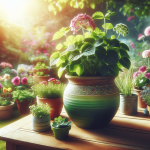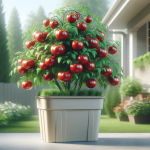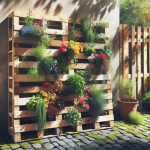This post may contain affiliate links. As an Amazon Associate, we may earn commissions from qualifying purchases.
Have you ever wondered what the best practices are for growing fruit trees in containers? If you’ve ever dreamt of plucking ripe, delicious apples or juicy peaches from a tree right on your porch or balcony, then you’re in luck. Growing fruit trees in containers is not just a possibility; it’s a fantastic way to enjoy fresh fruit without needing a large garden space. And let’s face it, container gardening can be very fulfilling, offering versatility and the convenience of managing your mini-orchard right at arm’s reach.
You’ll find that with the right tips and tricks, your container-grown fruit trees can thrive as well as their garden-planted siblings. Grab your trowel, put on your gardening gloves, and let’s get started!
Why Choose Container Gardening?
Container gardening, especially for fruit trees, offers an array of benefits. It’s particularly advantageous if you’re limited on space or have less-than-ideal soil conditions. Growing fruit trees in containers allows for greater control over the growing environment, including soil type, water, and fertilization. Plus, you can easily maneuver your containers to ensure they get the right amount of sunlight.
Benefits and Drawbacks
Every gardening method has its ups and downs, and container gardening is no exception. Here’s a table that gives you a quick look at the most common benefits and potential drawbacks:
| Benefits | Drawbacks |
|---|---|
| Flexibility in placement | Limited root space |
| Control over soil and nutrients | Requires frequent watering and feeding |
| Minimal weed problems | Can be heavy and difficult to move |
| Easier pest management | Trees may become root-bound |
| Great for small spaces | Need for repotting as tree grows |
| Portable – can move for optimal sun |
Choosing the Right Container
The first step to growing fruit trees in containers is, unsurprisingly, to choose the right container. This decision will heavily influence how well your fruit tree grows and whether it thrives or just survives.
Size and Material
You’ll find containers made from various materials such as plastic, ceramic, and wood. Each material has its attributes:
- Plastic: Lightweight and often less expensive, it retains moisture well but may not offer the best insulation against extreme temperatures.
- Ceramic: These are heavier and provide good insulation. Ensure they have drainage holes to prevent waterlogging.
- Wood: Aesthetic and good for insulation but can degrade over time. Always opt for rot-resistant types like cedar.
As for size, bigger is generally better. A dwarf or semi-dwarf fruit tree will need a container that’s at least 20 inches in diameter and 24 inches deep. This size supports the root system and provides enough space for the tree to grow.
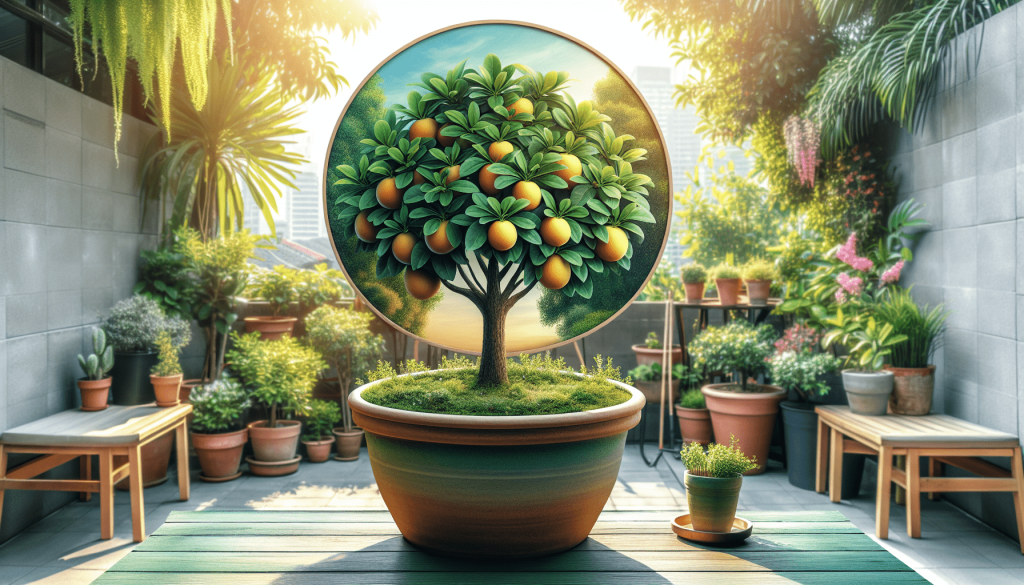
Selecting the Right Tree
Now that you’ve got your perfect container, it’s time to pick the right fruit tree. Not all fruit trees are suitable for container growth, so it’s crucial to select a variety that will thrive in the confines of a pot.
Best Varieties for Containers
Dwarf and semi-dwarf varieties are the go-to choices for container gardening. These trees are bred specifically to be smaller in stature while still producing fruit that’s just as delicious and abundant. Here are some popular choices:
| Fruit Tree | Recommended Variety |
|---|---|
| Apple | Dwarf Honeycrisp, Gala |
| Peach | Bonanza, Pixzee |
| Lemon | Improved Meyer Lemon |
| Fig | Little Miss Figgy, Violette de Bordeaux |
| Cherry | Dwarf Stella, North Star |
| Olive | Arbequina, Picholine |
Ensure you select a variety that is self-pollinating or have multiple trees for cross-pollination if needed.
Preparing the Container
Before you plant your fruit tree, you need to prepare your container adequately. This involves ensuring proper drainage, using the right soil mix, and providing a solid foundation for your tree to grow.
Drainage
Drainage is a critical factor to prevent root rot. Make sure your container has several drainage holes at the bottom. If it doesn’t, consider adding some or look for a different pot. You can also place a layer of gravel or small stones at the bottom to further improve drainage.
Soil Mix
The soil you use needs to be rich in nutrients but also well-draining to prevent water from pooling around the roots. Regular garden soil isn’t ideal for container plants as it can be too dense. Opt for a high-quality potting mix containing a blend of perlite, peat moss, and aged compost. You might even find special potting mixes formulated explicitly for fruit trees.
| Component | Purpose |
|---|---|
| Perlite | Improves aeration and drainage |
| Peat moss | Retains moisture |
| Aged compost | Provides essential nutrients |
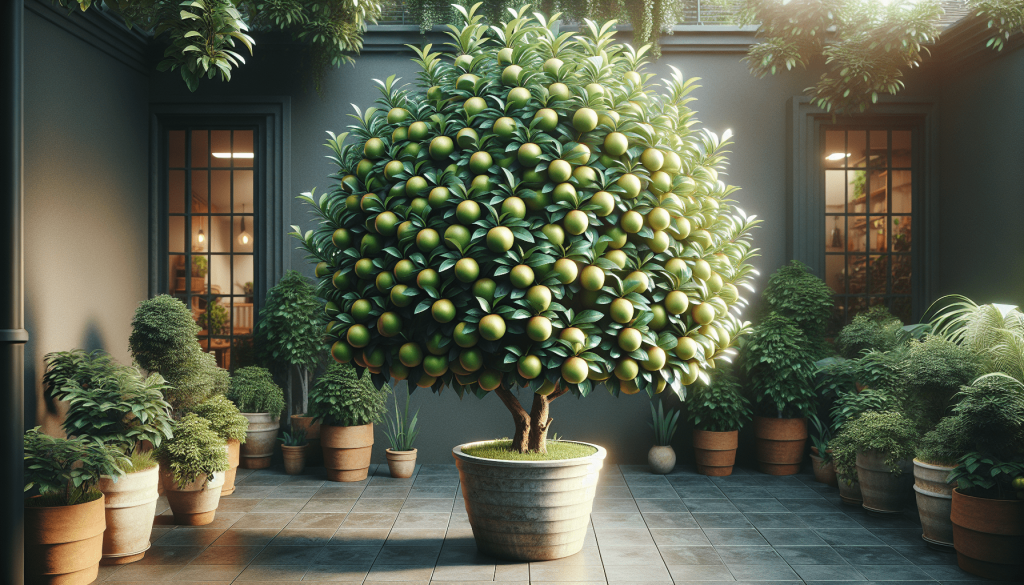
Planting Your Fruit Tree
Now comes the fun part—planting your fruit tree. Start by filling your container about halfway with the soil mix. Remove the tree from its nursery pot and gently tease apart any circling roots. Place the tree in the center of the container and fill in around the roots with more soil mix, ensuring the soil level is right up to where the root ball meets the trunk.
Watering and Initial Care
Once planted, give your tree a thorough watering to help settle the soil and eliminate air pockets. From this point forward, you’ll need to establish a regular watering schedule. Most container-grown fruit trees require frequent watering, often once a day during the peak summer months.
Maintaining Your Fruit Tree
Ensuring your tree’s health and productivity involves regular maintenance. This includes watering, feeding, pruning, and dealing with potential pests and diseases.
Watering Schedule
Container-grown trees dry out faster than those in the ground. Check the soil moisture regularly and adjust your watering schedule accordingly. A consistent watering schedule is crucial for fruit production.
Feeding Your Tree
Fruit trees in containers deplete the soil of nutrients more rapidly than those planted in the ground. Feed your tree with a balanced, slow-release fertilizer every few months. During the growing season, you can supplement this with a liquid fertilizer.
Pruning
Pruning is important to help maintain the shape and size of your tree, especially in a confined space. Prune in late winter or early spring before new growth starts. Remove any dead, diseased, or overcrowded branches to improve air circulation and light penetration.
Pest and Disease Management
A significant advantage of container gardening is the ease of pest management. Keep an eye out for common pests like aphids, spider mites, and scale. Use organic sprays or neem oil to manage minor infestations.
Overwintering Your Tree
If you live in an area with harsh winters, overwintering your container-grown fruit tree can be a bit of a challenge. You’ll need to take steps to protect your tree from freezing temperatures.
Bringing Inside
One option is to bring your tree indoors as soon as temperatures start to drop. Place it in a cool, bright location like a sunroom, garage, or greenhouse.
Outdoor Protection
If moving your tree indoors isn’t feasible, wrap the container with bubble wrap or burlap to insulate the roots. Mulch the surface of the soil to protect against frost.
Conclusion
Growing fruit trees in containers is a delightful way to enjoy fresh, home-grown fruit even if you’re short on space. By choosing the right container, selecting suitable tree varieties, and providing meticulous care, you can create a thriving mini-orchard. Remember, the key to success lies in preparation, ongoing maintenance, and a bit of patience. Happy gardening, and may your containers overflow with juicy, delicious fruits!



